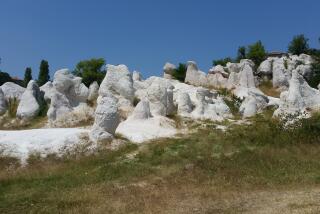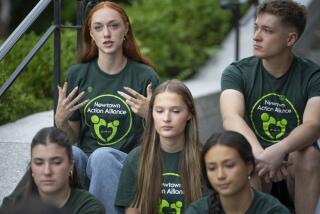Rash of teen suicides stuns Palo Alto campus
PALO ALTO, CALIF. — The small squares of colored paper began cropping up on the doors and walls of Henry M. Gunn High School last week, two days after William Dickens, 16, killed himself on the nearby train tracks.
“Just keep swimming,” one Post-it note said. “There is always someone who will listen,” was written on another. And, “There’s no meaning to happiness w/o sadness. Take it easy.”
Dickens was the fourth Gunn student in less than six months to commit suicide near where East Meadow Drive crosses the Caltrain tracks here in the affluent, high-achieving heart of the Silicon Valley. A fifth student tried to kill himself but was thwarted by his mother, who suspected his intentions, followed him to the crossing and saved him with the help of a passer-by.
Community meetings and counseling sessions, soul-searching and finger-pointing have not stopped Palo Alto’s suicide cluster from growing and have been hard-pressed to comfort grief-stricken families, friends and teachers.
But as debate continued over how to stop the deaths and improve safety at the crossing where the young people stepped in front of moving trains, Sophia Jiang launched Operation Beautiful.
The 16-year-old Gunn junior got the idea online while looking for something that “would make myself feel better after hearing about this death,” she said in an e-mail. Jiang posted her idea on Facebook and, along with her classmates, began pasting a blizzard of paper scraps with messages of affirmation around campus.
The idea was to “give students a little bit of hope and sunshine to look up at after the darkness and rain,” she said. “It was kind of like telling each other we were all in this together and that we were going to get through this.”
Psychiatrists, suicidologists and experts in child development warn that the worst response to teen suicide is to make it seem glamorous or normal. They caution against shrines. They teach depression’s warning signs, which can include changes in interest level, difficulty concentrating and increased isolation. And they believe that focusing on survivors’ pain is a key deterrent.
These days, it would be hard to find a better place to witness suicide’s devastation than graceful, sprawling Gunn High School, with its stately redwoods and park-like grounds.
“These past few weeks have been difficult for all of us in the Gunn High School Community,” reads a message on the guidance office window. “If you need emotional support at this time or if you are concerned about a friend, please come by the counseling office at any time during the school day.”
The community is “shattered,” said Philippe Rey, executive director of Adolescent Counseling Services, which offers free assistance to students at eight schools in the region, including Gunn.
One teen suicide “is already difficult,” he said, but “two, three, four is really tragic. There’s a sense of hopelessness and social depression.”
After the first two suicides in spring, school officials scheduled grief counselors and community meetings and spoke publicly about the tragedies. “You don’t ever come to terms with it,” Gunn Principal Noreen Likins told the San Jose Mercury News in early June.
Then an incoming freshman killed herself at the Meadow Drive railroad crossing days before the school year began in August, followed by Dickens’ death. Officials are now keeping a low profile. Likins’ office referred inquiries to Kevin Skelly, superintendent of the Palo Alto Unified School District. He declined to comment.
Likins sent a two-paragraph e-mail to Gunn parents last week saying simply that “William took his own life. We at school are all struggling to come to terms with this incomprehensible loss.”
Suicide experts throughout the country have been contacted. Physicians from Lucile Packard Children’s Hospital at Stanford, local clergy, Caltrain officials and education experts have all been tapped for solace or planning about how to teach depression’s warning signs and increase resilience.
It remains unclear what is behind the deaths. Caltrain spokeswoman Christine Dunn said that the first two have been declared suicides, while the last two are still under investigation, although they “appear to be intentional.”
The crossing itself is plain, weedy and less than two miles from the Gunn campus. Some have requested that a permanent memorial be erected at the site, but the last thing Caltrain wants is to romanticize the suicides or create a safety hazard. Train crews would “have to see that every day,” Dunn said, “and it’s very painful for them.”
Suicide is the third leading cause of death for teenagers, after accidents and homicide. Teens are suggestible and impulsive, said Dr. Mel Blaustein, who has studied suicides on the Golden Gate Bridge, and if the first death “was romanticized and seemed like something special, that can start a cluster.”
Jean-Paul Blanchard, 17, walked onto the tracks in front of a fast-moving train on May 5, during the two-week period that Gunn students were taking Advanced Placement tests, which grant them college credit and confer prestige upon their schools. Early talk blamed the region’s high standards for causing undue pressure.
Then, on June 2, Sonya Raymakers, 17, ended up at the same crossing, with the same result. But she had already been accepted at New York University, so the pressure theory lost some currency. Catrina Holmes, 13, was the incoming freshman who died on Aug. 21. Dickens, a junior, killed himself three-tenths of a mile from the same spot.
“Stress is part of the component, but we can’t say it’s the cause of everything, the main reason these kids are doing it,” said Denise Pope, a senior lecturer at Stanford University and author of “Doing School: How We Are Creating a Generation of Stressed Out, Materialistic and Miseducated Students.” “Several of these kids were depressed.”
Dylan Paddock, a 17-year-old senior, said his physics instructor found it impossible to teach on Oct. 20 after reading the announcement of Dickens’ death. So he took the class on a walk around campus and the park behind it. They talked, walked and watched the ducks.
“The teachers have it the hardest in all this,” Paddock said. “They don’t know how to deal with the fact that their students are killing themselves.”
Said sophomore Andriy Khrustalyov, 15: “My Spanish teacher was crying all day after this latest one. The staff seems emotionally hurt. They want us to pull together and help each other.”
Khrustalyov has volunteered to be a peer counselor through the school’s new ROCK program, also known as “Reach Out. Care. Know.”
About the time Operation Beautiful was born, a blog called HMGGMH was created. It was modeled after GivesMeHope.com, a forum where people share uplifting moments and shore each other up against the vagaries of life.
A student who signed a post “Hippopotamus” said he was grateful for the English teacher who is “a flipping awesome guy” because he checks in on students who seem sad.
“TheOtherOne” wrote on Sunday that “this was the longest week of my life. The day after Sonya died, my dad lost his job. This week has been a reminder of all the residual pain and topped with new incomprehensible pain from losing Will.”
Then there was “Anonymous Teacher,” who wrote on Oct. 22 about being “humbled by my job . . . by my students . . . by the conception and delivery of this site.”
“As I write this, there are tears running down my face for the students I have lost,” the teacher wrote. “But I also remember with distinct clarity how I am privy to the growth of my students and how they truly make me laugh and smile.”
Most of the Gunn bloggers sign off, “HMGGMH”: Henry M. Gunn Gives Me Hope.
--
More to Read
Sign up for Essential California
The most important California stories and recommendations in your inbox every morning.
You may occasionally receive promotional content from the Los Angeles Times.











